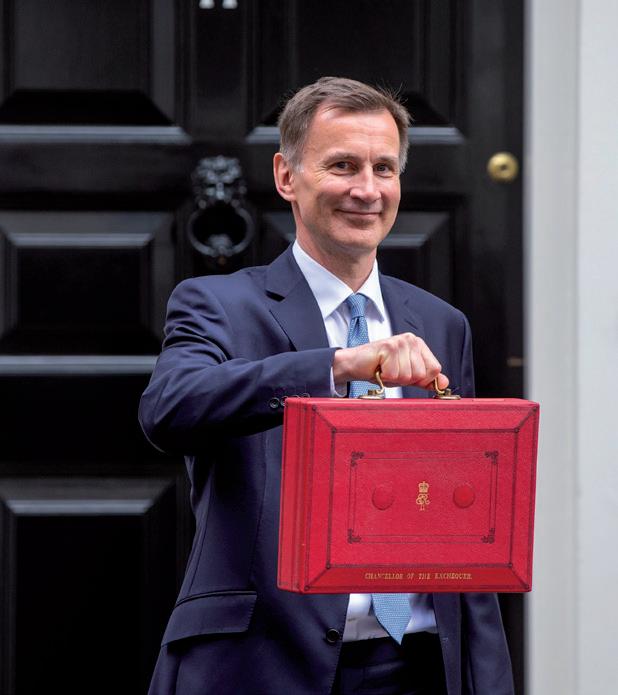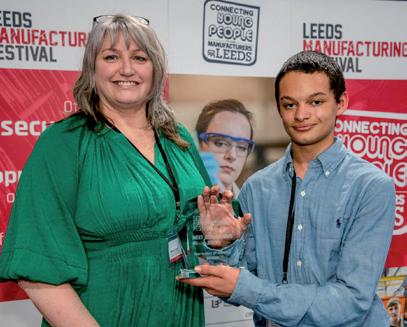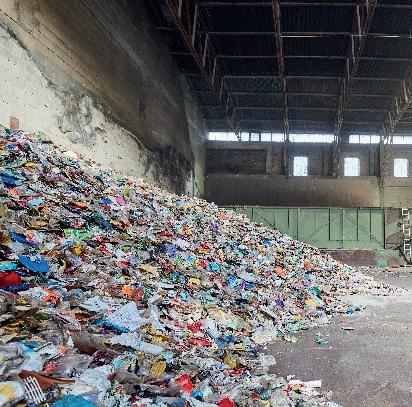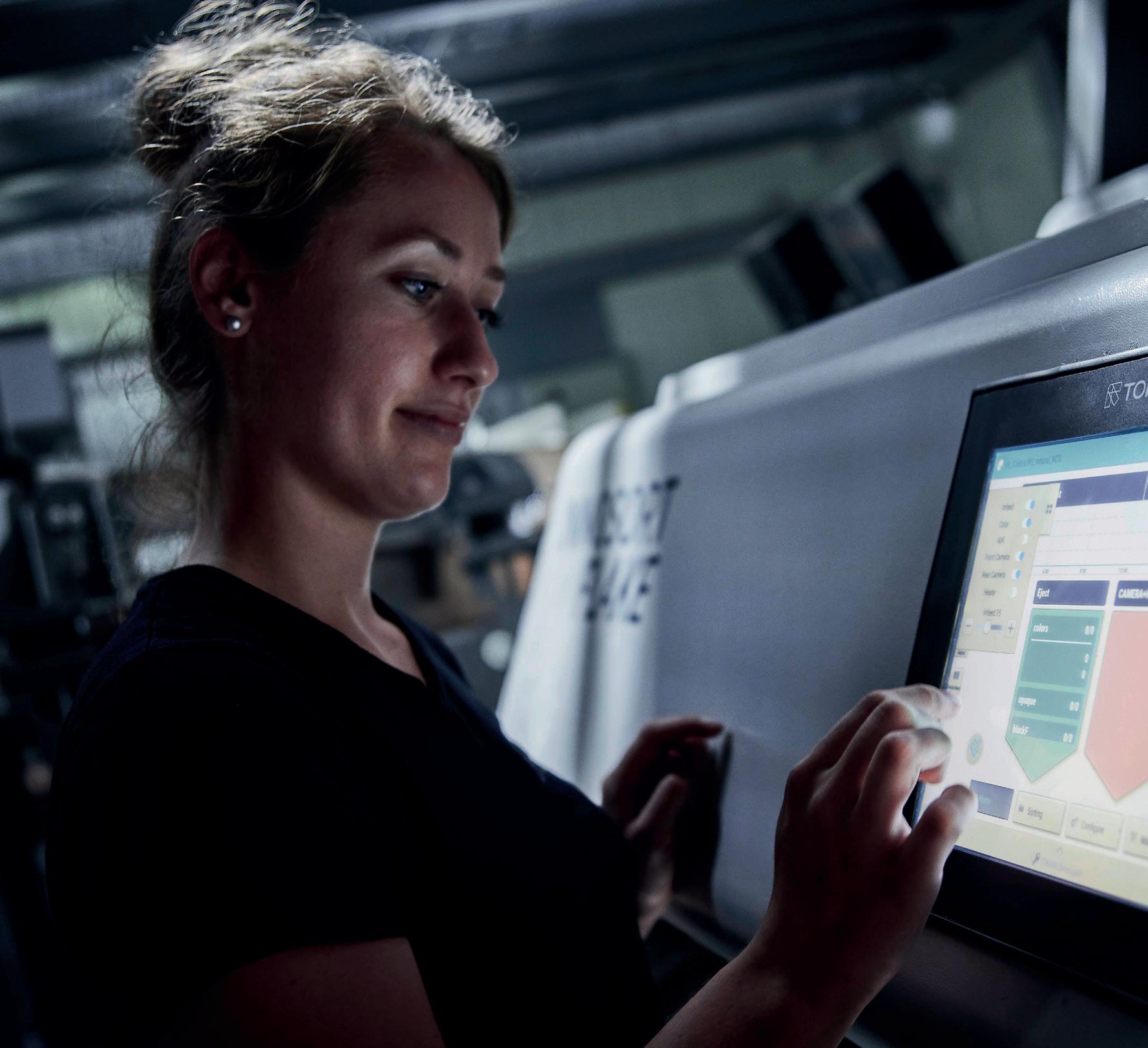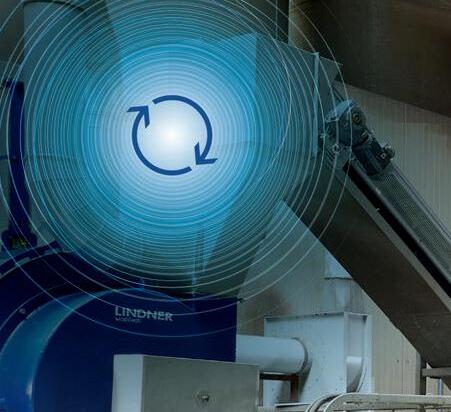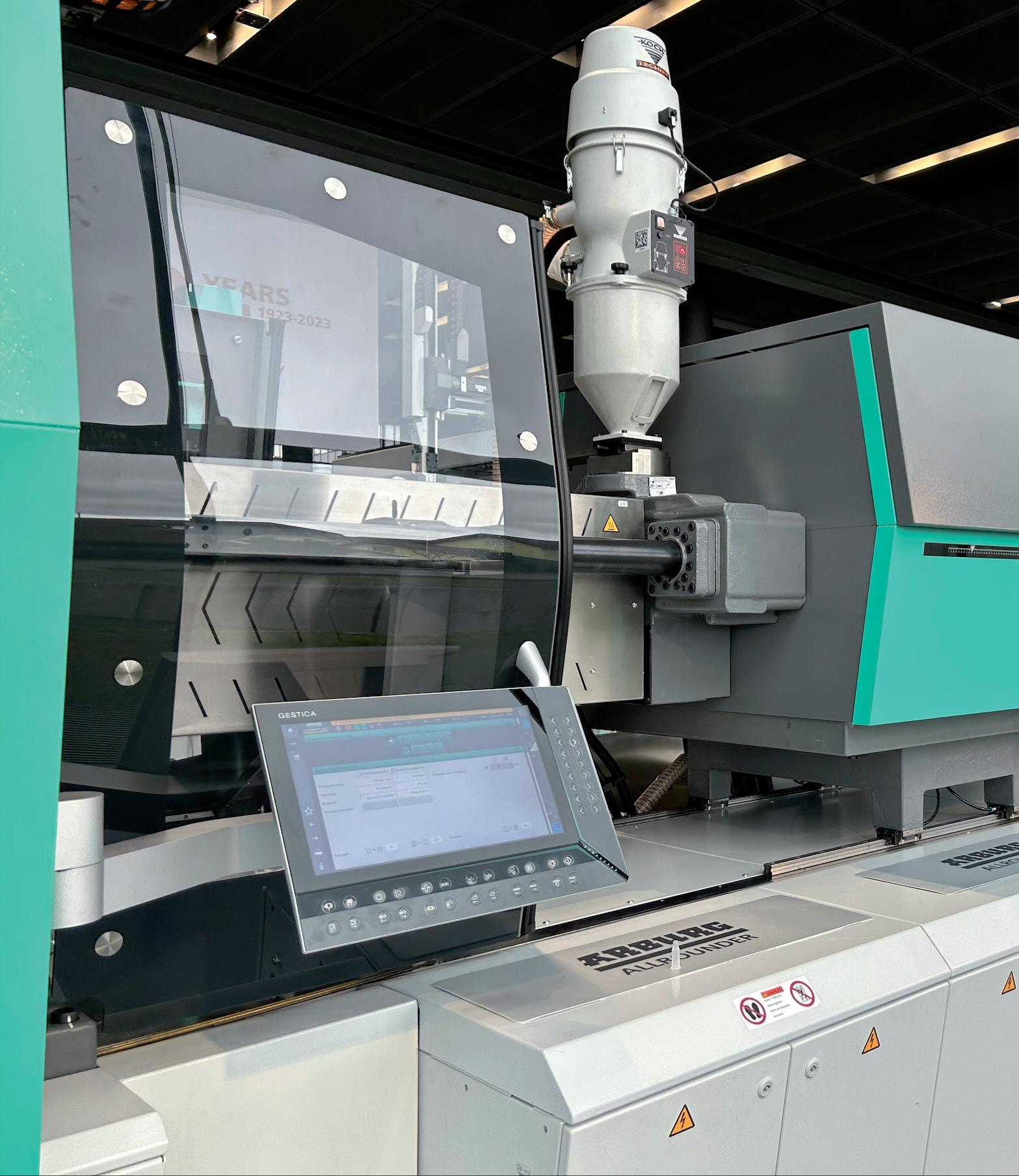
11 minute read
EXPERT DISCUSSION:
from BP&R Mar 23
Energy savings in injection moulding
With energy prices still causing massive headaches for processors around the UK, BP&R’s Dave Gray hosted a roundtable discussion between three key stakeholders in the UK plastics industry to explore some of the options for easing the pressure.
Dave Gray: I want to start by asking you all, with energy prices continuing to be such a huge challenge for the industry, is the plastics industry taking things seriously enough? Have processors been quick enough to take action?
Robin Kent: The reality is no. This has been gestating for probably 10, 15 years. I’ve been doing energy management as a full-time job since about 1998, and I still struggle to get people to engage. I can remember back in 2001, when they put the climate change levy on, and that was going to be 0.43 pence per kilowatt hour, and everybody was going, oh, it’s going to be the death of the plastics industry. Would that we were back there where energy was costing about 0.43 pence per kilowatt hour. I really think the industry hasn’t taken notice early enough or taken it seriously enough. This is selfinflicted.
Dave Gray: Carl, what do you think?
Carl Reeve: I have to agree with Robin. We’ve been banging on about energy efficiency for five or six years. We can demonstrate a model whereby you can buy a new all electric machine and pay for it on electricity savings alone inside five years. I do think that the current crisis has brought it to the fore. And I think people are reacting now. But I don’t feel they’re acting quickly enough, and not across the board. Even now, I think people are still holding out hope that prices will drop and everything will go back to how it used to be.
Dave Gray: And Jo, you’re here as an example of someone who has been proactive both before and throughout the current crisis. Why do you think that Robin and Carl might have come up against this reluctance or hesitation within the industry?
Jo Davis: I think it’s to do with cost. Previously, the cost of power was a relatively small percentage of our overheads. And it’s only now that it’s a large percentage of our overheads that people are more interested, and there’s now so much more justification for moving to, for example, an electric machine, than there was. And people are nervous of change. You know, you’ve got your processors who know how to use the machines they’ve got, they know how to use that type of machine, or that particular brand. I think a lot of people can be nervous about that.
Dave Gray: Well on that point, how easy was it for you the first time you replaced a hydraulic machine with an electric?
Jo Davis: I just don’t think there were any real challenges. Apart from the fact that it was a more expensive machine to buy than a hydraulic, but we realised we just needed to do it. And it’s proved a success and it’s what we will do now with our other machines going forwards, as soon as we can.
Robin Kent: In a way, and I hate to say this, but I think our model of manufacturing is broken. And, the reason I say it’s broken is because most of us were brought up to think about direct labour only. We always thought, “if we can only get our cost of direct labour down, then everything will be all right”. And we’ve forgotten that the direct labour is actually almost insignificant now in comparison to energy costs. The savings you can make by reducing direct labour, they’re not there anymore. You’ve got to go for the other stuff. The next online is energy, and then after that you have to go for materials.
Dave Gray: How long has this been the case, Robin?
Robin Kent: Oh, many years. In my experience, if you go to the Far East – China, Thailand, Indonesia, anywhere like that – where direct labour costs are really low, their energy costs as a percentage, are second only to their raw materials cost. And these are the most energy efficient factories in the world, because it’s their second most important cost.
Dave Gray: For those people who still insist that there hasn’t been much advancement in technology for years, what do you say to that?
Carl Reeve: There’s been massive development there, there’s been a step change in technology from hydraulic to servo-hydraulic machines as a first stage, and then of course electric machines. We [Haitian] are on our third generation of electric machines. If you look at our second generation and our third generation, there is a marked improvement on energy consumption. We are doing energy trials now where customers are switching from a hydraulic machine, and again, like the average in market, 20 odd year old European manufactured, to a third generation electric machine. They’re saving 75-80% on average across the jobs that they’re running. It’s massive. In terms of their current energy rates, they signed up this year for 70 pence, and they were pleased with that at the time. That machine pays for itself in 13 months on electricity alone. That’s a massive change in
READ –LISTEN –LEARN
This article is also available as a podcast episode via the Interplas Insights podcast. Scan the QR code to listen and subscribe.

the market, and, when we tell people these figures, they literally don’t believe them. Which is why I carry Robin’s book around, and I recommend it all the time, because it’s not just our machines. Obviously I’d love people to buy Haitian machines. But this technology exists out there and it’s available across the board.
Robin Kent: I think you’re absolutely right Carl. And I see it because I’ve been benchmarking machines, hydraulic, all-electric for probably, 20 years now, and I’m actually seeing that my benchmark curve, which I first put together in about 2003, is showing the new generation
Chair: Dave Gray, Head of Content, British Plastics & Rubber/ InterplasInsights.com
Panellists: Jo Davis, managing director at contract moulder Broanmain Plastics

Robin Kent, managing director at plastics consultancy Tangram Technology


Carl Reeve, managing director at Premier Moulding Machinery, the UK sales arm for Haitian machines machines coming in well under that benchmark. We are actually seeing huge improvements in the generations of electric or servo hydraulic machines. The machines that were around in 2002/2003, which were the early machines, their savings are now being dwarfed by the 2022/2023 models.
But it’s not just about the injection moulding machines. It’s about compressors, it’s about chillers, it’s about all of the technology. Years ago when I advising people to fit variable speed drives to pumps, they were incredibly expensive, and the payback time was two or three years. The payback time for variable speed drives now is months, six months, it becomes not a CapEx proposal, it’s an OpEx. Just go and buy it, do it, fit it, it’s done and it pays back in six months.

Dave Gray: So Jo, just reflecting on some of the numbers that Carl quoted, does that come as a surprise to you, given your real world experience of upgrading your machines?
Jo Davis: Absolutely. And we’ve got meters measuring our usage on about 50% of our machines. And we’ve got it on our compressor and various other things, and we’re moving them around all of the time. We can measure the difference between our 180 tonne, which is electric, and our 25 tonne, which is using six times more than our 180 –it’s significant. But it is hard as a small business to make so many investments, you’re taking on a lot of borrowing to do that unless you’ve got cash in the bank, so that’s difficult.
Dave Gray: Well that leads me nicely onto my next question, which is to ask the panel, what support is there out there at the moment for CapEx?
Carl Reeve: We do a lot of energy surveys and so we see a lot of moulders, and they approach it in many different ways. One of the comments people make is that they’re nervous about taking cash out of the bank.
We’ve got lenders that we work with, and they’re very keen on anything that shows energy savings. So HSBC is ours, and when you talk to them about loans, everything’s up in the air. And then you tell them what the payback periods are on this type of machinery, and their ears prick up because they’re keen on things that show energy savings and sustainability.
Dave Gray: And in terms of government support, what’s available there and does it work? Is it complicated?
Carl Reeve: Well, the super deduction tax comes to an end in March this year. I’m surprised that it hasn’t been used as much as it could’ve been, but where people have used it, it’s brilliant. >
If you make profits, you get 130% back on your capital allowances, which if you’re buying new equipment, is effectively a 25% discount on whatever you buy.
Thanks to that, we’ve got clients who have upgraded almost their entire fleet in the last two years. Then there’s the Energy Transformation Fund, which is run as a competition. You get a percentage change between the price of an energy efficient piece of equipment and a standard piece of equipment – it’s next-to-useless. For SMEs to have jump through so many hoops to get a relatively small amount of money, just didn’t seem to make any sense. And I think it’s fair to say we don’t offer anywhere near as much support for business as our European competitors.
We need to compete globally, so we need to be efficient. We’re running a very old fleet of equipment in this country – I think the oldest fleet outside of Romania in the developed world. And so modern equipment means lower prices for production.
I mean, if we upgraded the fleet of moulding machines in the UK to even to servo-hydraulic, we’d save about 400,000 households of electricity every year. And when we’re looking at global security and worried about where we’re going to get our energy from, we should be looking at that. And I think the government should be driving that.
Dave Gray: Jo, from your side, do you feel that the government funding that’s been available was well understood? And do you think your fellow SMEs are aware of the private funding that may be available?
Jo Davis: We keep our eye out on any government funding and any bank private funding. I would say that government funding can be quite difficult to understand, and so we tend to fund things privately.
Robin Kent: The important bit is that you can’t really help people who won’t help themselves. Companies aren’t doing even simple things, which they can do at no cost or at extraordinarily low cost, to actually help themselves.
Dave Gray: Well in your book you talk about a potential 30% in energy savings, and as you say, there is no magic bullet. So what’s the bigger picture?
Robin Kent: Well, I mean, I always try and divide it up to make it easy for people. Ten percent is pure and simple management. It’s the sort of stuff that Jo is doing. It’s monitoring your machines, understanding where your energy is going. Monitor what we call ‘M and T’, monitoring and targeting. And most of that management stuff can be done in six months, three to six months, bringing 10% savings.
The next bit is what I call the maintenance stuff, which is generally the CapEx. That’s things like compressed air leaks, compressed air use chiller, chilled water insulation, chilled water controls, variable speed drives, all of those sort of low cost things. They’re the sort of things that maintenance guys can do fairly easily.
Payback times for that, for the maintenance stuff, nine-to-12 months. And then there’s the other 10%, which comes from the technology, the CapEx stuff, which is really the machines. So 20% savings are accessible virtually with low payback times, and low CapExes, or in fact, no CapExes.
But you go into companies and a colleague of mine, he’s going into a company next week and he said, basically, they don’t know how much they spend on energy. Well, frankly, that’s stupid. I won’t tell you what the company’s name is, but frankly, if you don’t know what you’re spending on energy, that’s not a failure of technology or a failure of investment, that’s a failure of management. You can’t help those who won’t help themselves. Jo and her team are helping themselves.
Dave Gray: And Robin, you’ve been doing this work for a number of years, do the companies you visit tend to keep up the best practice over time?
Robin Kent: Well this is a huge cultural change. People move on, companies move on, and it needs constant reinforcement.
Dave Gray: So Jo, going back to this idea of culture change, what was the situation like before you started making changes, and then what changes did you implement?
Jo Davis: We weren’t doing anything before I went on the course with Robin. We thought we were, with things like turning off the lights, etcetera. We thought we were doing our bit, but we didn’t even publish our power consumption to our team. I monitored it, but I didn’t really do anything with it. So we started by sharing that information for three months. Then we made some changes. The first thing we did was look at our compressor and our chiller, and when they were being used, when they shouldn’t be used. And that’s made a massive change, straight away.
We’ve also had widgets fitted to our machines that that measure what they’re using, which is brilliant because everyone can log in and view that. Our team are quite enthusiastic about tech, so they like doing that. I think I’m really lucky because everybody in our management team is enthusiastic about sustainability.
Dave Gray: And how do you plan to maintain better habits?
Jo Davis: We have nine company objectives each year, and power and sustainability now forms one of those, which it didn’t before. We’re now measuring the cost of power as a percentage of turnover, which we didn’t before, and we have that as a target. So if that slips, it flags up that there’s something wrong there, and we’re publishing the data.
Also, everybody has very regular one-to-ones and annual objectives, and within those, we focus on waste, because actually most waste costs us power.
Robin Kent: Many years ago I worked with probably one of the finest energy managers in the plastics industry, and he took over a company trained everybody from the management to the shop floor in the basics of energy management. A 40-minute training program delivered consistently over five shifts to everybody, and the next month their energy use dropped by 20%. And the next month, that 20% was maintained just simply by getting the workforce engaged.
Now, I hate to make a plug here, but that training course is available for free. So you can download it. It’s a PowerPoint training program with trainers notes, and we’ve seen companies that train from top to bottom the consistent message about what we want to do actually achieve remarkable things.
One of the approaches I use when I’m doing an energy survey is to walk onto a factory floor and I say, “take me to a machine that’s not producing anything, that’s stopped”. So we’ll go to machines that are stopped and they’ve been stopped for two weeks or something like that, and there’s air leaking out of them. The chilled water is still running through the tool, the, the conveyors are still running.
Even the main hydraulic motor, which as Carl says, uses up to 75%. The base load for a hydraulic machine is about 75% average, and you can find all of these things on a stopped machine. Just stop doing stupid stuff.






















